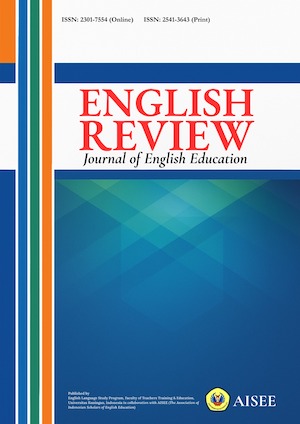THE IMPACT OF AI QUILLBOT IN IMPROVING STUDENT WRITING ABILITY TO WRITE ARGUMENTATIVE ESSAYS
Abstract
The integration of Artificial Intelligence (AI) in language learning has transformed academic writing, particularly in English as a Foreign Language (EFL) contexts. AI-powered writing tools such as QuillBot offer real-time feedback, automated paraphrasing, and grammatical enhancements, potentially improving students’ writing proficiency. However, limited research explores the specific impact of QuillBot on argumentative essay writing in EFL classrooms. This study aims to examine the effectiveness of QuillBot in enhancing the writing skills of third-semester EFL students at Universitas Darma Persada, Indonesia. Using a quasi-experimental design, 60 students were divided into an experimental group (QuillBot-assisted learning) and a control group (traditional instruction). Pre-test and post-test essay scores were analyzed using SPSS 27.0 to assess improvements in structure, coherence, and grammar. The findings revealed that students using QuillBot showed significantly higher improvements in writing proficiency compared to those in the control group. The experimental group demonstrated enhanced argumentation, coherence, and grammatical accuracy, indicating that AI-assisted tools can be effective in fostering writing development. The study concludes that QuillBot is a valuable supplementary tool for EFL writing instruction, providing instant feedback and reducing students’ dependency on traditional teacher-led corrections. Educators are encouraged to integrate AI writing assistants into teaching methodologies to optimize learning outcomes. Future research should explore the long-term effects of AI-assisted writing on different writing genres and across diverse educational contexts.
References
REFERENCES
Creswell, J. W. (2012). Education research planning conducting and evaluating quantitative and qualitative research. Pearson Education.
Farrokhnia, M., Banihashem, S. K., Noroozi, O., & Wals, A. (2023). A SWOT analysis of ChatGPT: Implications for educational practice and research. Innovations in Education and Teaching International, 1–15. https://doi.org/10.1080/14703297.2023.2195846
Mammadova, T. (2019). Teaching Grammar to a Grammar-Free Generation. Cambridge Scholars Publishing.
Maharani, M. M. (2018). Graphic Organisers to Improve Students' Writing on Recount Paragraphs. Metathesis: Journal of English Language, Literature, and Teaching,
(2), 211–221. https://doi.org/10.31002/metathesis.v2i2.942
Meiningsih, S. (2021). Rolling Ball - Learning Cell dalam Pembelajaran untuk Meningkatkan
Keterampilan Menulis Bahasa Inggris Siswa. 8(2), 190–196. https://ejournal.undikma.ac.id/index.php/pedagogy/index%0AVol
Faller, J. M. V. (2018). Grammarly investigation into EFL writing issues involving Omani
learners. International Journal of Language & Linguistics, 5(3), 165-174.
https://doi.org/10.30845/Ijll. V5n3p16.
Dale, R. (2020). Natural language generation: The commercial state of the art in 2020. Natural
Language Engineering, 26(4), 481–487. https://doi.org/10.1017/S135132492000025X
Fitria, T. N. (2021). QuillBot as an online tool: Students’ alternative in paraphrasing and rewriting of English writing. Englisia: Journal of Language, Education, and
Humanities, 9(1), 183. https://doi.org/10.22373/ej.v9i1.10233
Geitgey, A. (2018). Natural language processing is fun! How computers understand human language. Medium.
Heaven, W. D. (2020). OpenAI’s new language generator GPT-3 is shockingly good and completely mindless. MIT Technology Review.
Kinga, S., & Gupta, G. S. (2021). Platforms as foundation of sharing economy. Delhi Business
Review, 22(1), 1–13. https://doi.org/10.51768/dbr.v22i1.221202101
Kholis, A. (2018). The effectiveness of using video and pictures in teaching writing hortatory exposition text. LingTera, 5(2), 189-198. https://doi.org/10.21831/lt.v5i2.15490
Kinden, C. E., & Prentice, F. M. (2018). Paraphrasing tools, language translation tools and plagiarism: an exploratory study. International Journal for Educational Integrity, 14(1), 1-16. https://doi.org/10.1007/s40979-018-0036-7
Peters, M., & Cadieux, A. (2019). Are Canadian professors teaching the skills and knowledge students need to prevent plagiarism?. International Journal for Educational Integrity, 15, 1-16.
https://doi.org/10.1007/s40979-019-0047-z
Moore, J. L., Rosinski, P., Peeples, T., Pigg, S., Rife, M. C., Brunk-Chavez, B., Lackey, D., Rumsey, S. K., Tasaka, R., Curran, P., & Grabill, J. T. (2016). Revisualizing composition: How first-year writers use composing technologies. Computers and Composition, 39, 1-13. https://doi.org/10.1016/j.compcom.2015.11.001
Maulidina, P., & Wibowo, H. (2022). The use of grammarly tools to enrich student’s writing ability. Lingua, 18(2), 179-189. https://doi.org/10.34005/lingua.v18i2.2246
Noroozi, O. (2022). The role of students’ epistemic beliefs for their argumentation performance in higher education. Innovations in Education and Teaching International, 1–12. https://doi.org/10.1080/14703297.2022.2092188
Rogerson, A. M., & McCarthy, G. (2017). Using Internet based paraphrasing tools: Original work, patchwriting or facilitated plagiarism?. International Journal for Educational Integrity, 13(1), 1-15. https://doi.org/10.1007/s40979-016-0013-y
Lynch, M. (2018, July 6). Consequences of the new digital childhood. The Tech Advocate. https://www.thetechedvocate.org/consequences-of-the-new-digital-childhood/
Pratama, Y. D. (2021). The investigation of using grammarly as online grammar checker in the process of writing. English Ideas: Journal of English Language Education, 1(2), 46-54.
All articles published in English Review: Journal of English Education (ERJEE) are licensed under the Creative Commons Attribution 4.0 International License (CC BY 4.0).
Copyright Ownership
Authors retain the copyright of their articles and grant ERJEE the right of first publication. The journal is granted a non-exclusive license to publish, reproduce, and distribute the article in any format, medium, or platform, provided that proper credit is given to the original authors.
License Terms – CC BY 4.0
Under the Creative Commons Attribution 4.0 International License, others are free to:
- Share — copy and redistribute the material in any medium or format
- Adapt — remix, transform, and build upon the material for any purpose, even commercially
As long as they:
- Provide appropriate credit to the original author(s) and source
- Provide a link to the license (https://creativecommons.org/licenses/by/4.0/)
- Indicate if any changes were made
There are no restrictions on the reuse, reproduction, or adaptation of published articles as long as attribution is properly given.
Author Warranties
By submitting a manuscript to ERJEE, authors confirm that:
- The work is original and does not infringe any existing copyright.
- The manuscript has not been previously published and is not under consideration elsewhere.
- All sources and references are appropriately acknowledged.
- Necessary permissions have been obtained for any copyrighted materials used.









